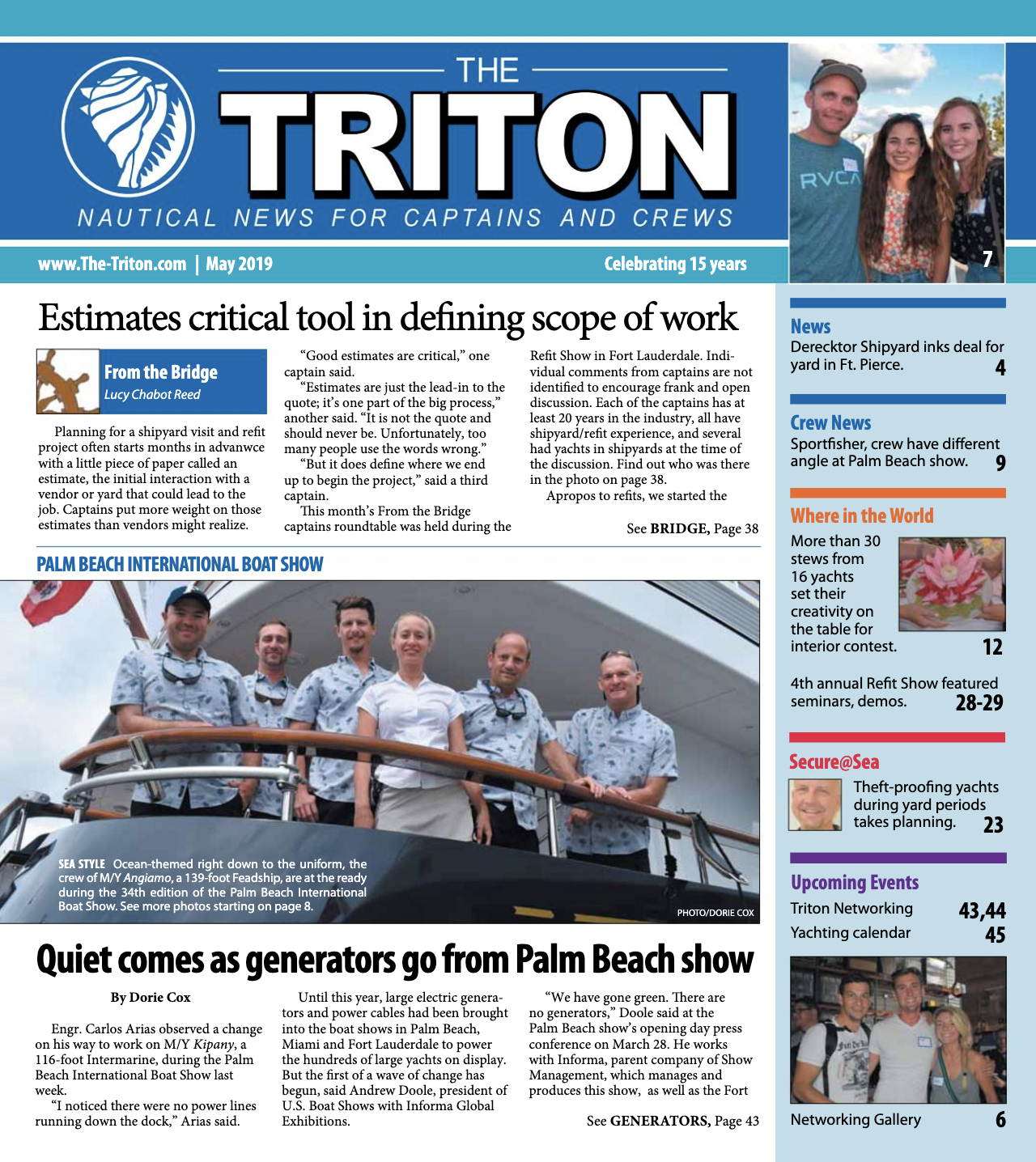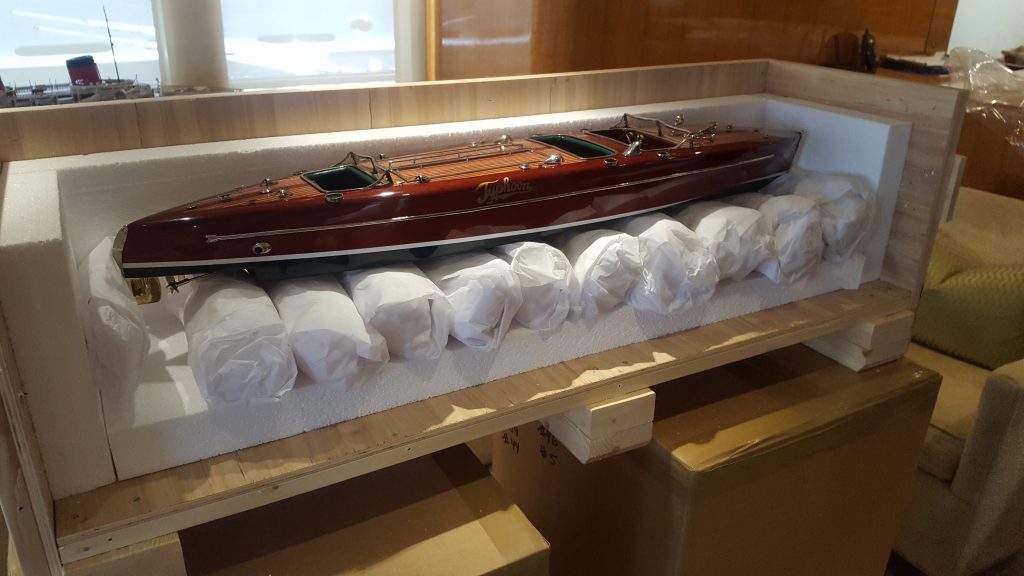Inventory First Step to Protect Art During Refit

By Lucy Chabot Reed
Even though chief stews are intimately involved with the yacht’s collection of art and its care onboard, protection of the artwork when the yachts heads to the shipyard is often left to the last minute, according to two specialists on the Art on Yachts panel at the Refit Show in Fort Lauderdale in mid April.
The key to changing that is for chief stews and captains to know exactly what they have onboard and what it is worth.
“When you think about it, art is one of the few parts of the yacht that can actually increase in value over time,” said Susan McGregor, owner of Bellissima Luxury & Fine Art Services and a panelist. “That’s an asset. To appreciate the values that you are working around is very important.”
“Knowing the value prevents you from making decisions as crew that could be damaging,” said panelist Amy Halffman, owner of Halffman Designs of Seattle. “We’ve all seen many times where crew will just lay a piece [of art] on the bed and cover it with a pillow case. If you do that with a piece that has value, and there’s dust, temperature changes, or other conditions — maybe the A/C goes out — you don’t want to ruin [the piece] and take that responsibility. Nobody wants to make that phone call.”

Susan McGregor of Bellissima, left, Triton Publisher Lucy Chabot Reed and Amy Halffman of Halffman Designs prepare to discuss Art on Yachts at the Refit Show in Fort Lauderdale in April. Photo by Dorie Cox
Interior crew is typically accountable for the care, custody and control of art onboard, whether that’s fine furniture, stemware, paintings or sculptures, even the owner’s personal belongings. Knowing what’s onboard and its value will help crew make decisions about how to protect it during a refit.
“The No. 1 thing is to plan ahead,” McGregor said. “Plan ahead with the art as you would plan ahead for any other work being done. You’re going to line up a vendor or take care of it yourself. Our rule of thumb is, if the power is going to be turned off, plan to remove it. When, where, how much art is coming off? Is it just art? Is it also stemware? Is it wine? Is it personal items, bedding, books?

Art, furniture, stemware and the owner’s personal belongings should be removed and secured during refits to protect them from temperature changes, dust and damage, the panelists said. A good art services provider will carefully custom pack items for transit and storage.
“Have an inventory,” she said. “What is coming off? Where is it located on the yacht? What are the dimensions, with the frame and without? An art services provider will want to do a site visit if possible to determine the volume of art, the type of art so they have the right materials. And we have to make sure you have the proper insurance. Those last-minute calls are really difficult.”
“Crew should know the materials behind the art, because if some of that artwork is coming off, it might not be coming back on, but your holes in that bulkhead will still be there,” Halffman said. “So how are you going to cover that up? You want it done in a timely manner because someone has promised [the owner] when they can have their boat.”
Not all artwork is high value, but it still must be treated with care. When crew are called in to manage the removal and storage of the art themselves, McGregor had a few tips.
“At a minimum, safely get it off the wall,” she said. “If you’re going to be driving it in your car, cool that car down before you get in. You are going to want to secure it. We don’t use bubble wrap. I’ve seen it melt; it doesn’t usually go well. What we recommend, at a minimum, is to stand the artwork up in a box. Put a piece of cardboard 1-2 inches bigger between them to keep them from damaging each other. With sculptures, put them in a box and gently pack with tissue paper or brown paper. Close the box so nothing else falls in there.”
Once secured for transit, make sure the art is stored in a climate-controlled environment. Many storage units are not climate-controlled and the artwork could be subject to humidity, mildew, insects and worst.
“The same thing goes for all the soft goods on the boat you have to remove,” Halffman said. “I shipped silk pillows down to Florida in plastic, airtight bags and threw them in a box. I did that just once.”
Clive McCartney, director of the yacht management division at Denison Yachts, asked the panelists about insurance.
“Boat policies will list item maximums or a total amount of art allowed onboard, and nobody has any idea what those are,” he said. “I want the art inventory so I can share it with the insurer and have them say yes, everything on this list is good to go and insured while it’s on the boat. Or they might say, ‘oh, that $150,000 item is outside our item maximum. Let’s underwrite this properly.’
“I’ve been doing this for 15 years, and I don’t think even many owners are paying attention to that level of particularity in terms of the insurance policy and the art,” McCartney said. “They assume someone is paying attention, but very often nobody is.”
If the yacht doesn’t already have an art inventory, going in for a refit is the perfect time to create one.
“Have the chief stew go around, take all the photos, create this document, and then delegate the research,” Halffman suggested. “Contact the designer or use Google to get some values. This should be a standard document on every boat.”
“And if you don’t have a value, estimate,” McGregor said. “If there is a claim, they would have to provide proof of value and documentation, but an estimate is a great start.”
Lucy Chabot Reed is publisher of The Triton. Comments are welcome below. To read more click here!
Recent Posts
What yacht crew should know about caring for art on yachts. Q&A with Bellissima Luxury & Fine Art Services.
Q. Art is a huge part of the personalization of a yacht, from paintings to sculptures to the furniture and even the carpet. What one or two key things should crew know about the “art” onboard a yacht? A. We use the phrase “care, custody and control” a lot. With that in mind, the most […]
Six Tips for Moving Into a New Condominium
Moving Into a New Condominium 1. Plan Ahead Create a Move-In Timeline. This should include things such as deliveries of new appliances, furniture, art installation, etc. Make a floor plan of where your larger belongings are going to be placed, including furniture, electronics, and art! 2. Get Familiar with the Logistics Is there parking for […]
Provenance: What It Is and Why It Matters.
Provenance: What It Is and Why It Matters. From the French word, provenir, meaning “to come from,” provenance is the chronology of the ownership, custody, or location of an object. Provenance is the documentation used to authenticate a particular art piece. These documents are used in general to establish authenticity, ownership, and value. In addition, provenance documentation can […]
Client Testimonials
We have been working closely with Susan and her team at Bellissima since 2017 and I must say we have had a fantastic experience. Very professional outfit and very easy to deal with. We have stored some pieces of art with quite...
I used Bellissima to pack, store and move our artwork, lamps and collectibles. I had heard they were great from other customers, but they were more than "great", they were wonderful. They are careful, responsive, dedicated and professional. I would highly, highly...
Hello Everyone - greetings from Bangkok, where the art shipment has just been delivered! Thank you all for making this happen with such a smooth, well planned and high-quality operation. From beginning to end you provided the greatest benefit any service can...
We have been working closely with Susan and her team at Bellissima since 2017 and I must say we have had a fantastic experience. Very professional outfit and very easy to deal with. We have stored some pieces of art with quite...
I used Bellissima to pack, store and move our artwork, lamps and collectibles. I had heard they were great from other customers, but they were more than "great", they were wonderful. They are careful, responsive, dedicated and professional. I would highly, highly...
Hello Everyone - greetings from Bangkok, where the art shipment has just been delivered! Thank you all for making this happen with such a smooth, well planned and high-quality operation. From beginning to end you provided the greatest benefit any service can...
We have been working closely with Susan and her team at Bellissima since 2017 and I must say we have had a fantastic experience. Very professional outfit and very easy to deal with. We have stored some pieces of art with quite...

